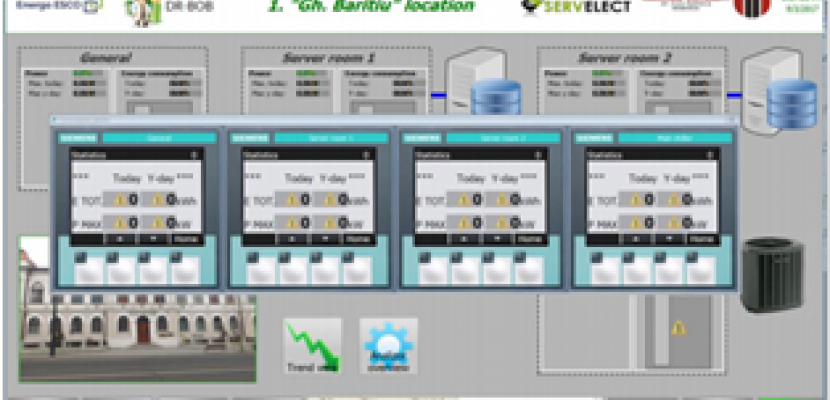Image

Demand Response and other innovative solutions implemented at Technical University of Cluj-Napoca
Published on 28 January 2022

Romania
Nord-Vest
This is the good practice's implementation level. It can be national, regional or local.
About this good practice
At the Romanian pilot site, a building and energy management system configuration was adopted in order to test different scenarios at 4 buildings of TUCN (Student’s dormitories, Swimming Pool, Faculty of Electrical Engineering and Faculty of Building Services). Also, partial retrofitting of the lighting system with LED technology was implemented in some of the classrooms. At the Swimming pool the main implementation was based on the pumps, introducing variable speed drive (VSD).
In this way, the project demonstrates the extendibility of the concept and good practices to local and also national public authority’s level. The knowledge transfer was tailored at different stakeholders.
The main benefits of the implementation of proposed solutions and demand response strategies are the following:
• Improved energy management actions;
• Engaging the energy managers of the universities, as 3 people from the technical staff benefited from Dr. BoB project and post-graduate course;
• Better understanding of the TUCN buildings and its costs with energy and utilities;
• A living lab demo site where students are directly implicated, with real time access to the BoB energy use.
The main stakeholders of the implemented solutions were, mainly, the students from the university and permanent staff, the solution being active in the Student’s dormitories, Swimming Pool, Faculty of Electrical Engineering and Faculty of Building Services. Almost 9800 people were directly involved in this.
In this way, the project demonstrates the extendibility of the concept and good practices to local and also national public authority’s level. The knowledge transfer was tailored at different stakeholders.
The main benefits of the implementation of proposed solutions and demand response strategies are the following:
• Improved energy management actions;
• Engaging the energy managers of the universities, as 3 people from the technical staff benefited from Dr. BoB project and post-graduate course;
• Better understanding of the TUCN buildings and its costs with energy and utilities;
• A living lab demo site where students are directly implicated, with real time access to the BoB energy use.
The main stakeholders of the implemented solutions were, mainly, the students from the university and permanent staff, the solution being active in the Student’s dormitories, Swimming Pool, Faculty of Electrical Engineering and Faculty of Building Services. Almost 9800 people were directly involved in this.
Expert opinion
Supply and demand fluctuations will be a developing challenge as we integrate more intermittent renewables into the grid, and shift towards electrification of sectors which are currently fossil fuel driven (in particular, mobility). Energy Management Systems will be an essential part of the demand-side management and can enable better understanding of where and when energy is used and how to optimise its use. The scenarios explored here involved shifting and rescheduling the work of certain technologies (chillers, ventilation units, etc.), away from peak times, and also had a behaviour change aspect, rewarding students for keeping their energy consumption within certain levels at requested times. The impressive energy savings achieve show high potential and demonstrate the efficacy of the solutions.
Works at
Interreg Europe Policy Learning Platform
Resources needed
Blocks of building, Server, Siemens Simatic Box P, Siemens PAC3100 Power Monitors for energy monitoring. Cost was approximately €47,000 as monetary resources.
Evidence of success
The electricity savings achieved were 779.6 MWh, meaning a reduction of 19.3% from total consumption. Respectively the total primary energy savings were 1.257 GWh.
Four of the TUCN buildings were used in order to test different scenarios and demand respond events.
Four of the TUCN buildings were used in order to test different scenarios and demand respond events.
Potential for learning or transfer
The presented good practices from Dr.BoB project reflect the success in knowledge transfer throw research and development, by implementing different innovative technologies, innovative approaches in order to educate, train and show a good example in the local community, but also at national, and European level.
Horizon 2020 research and innovation programme was created in order to shape the future, to support a more sustainable environment and to increase job possibilities. These are just a few objectives which were also achieved by the project.
Innovation should be based on research, passion and people and should address to people for their well-being.
Well-being is also a key factor of the presented project, because energy efficiency, renewable energy sources, less CO2 emissions contributes to a better life, better comfort and happiness among building occupants, employees and any other stakeholder, which can take part of the success.
Horizon 2020 research and innovation programme was created in order to shape the future, to support a more sustainable environment and to increase job possibilities. These are just a few objectives which were also achieved by the project.
Innovation should be based on research, passion and people and should address to people for their well-being.
Well-being is also a key factor of the presented project, because energy efficiency, renewable energy sources, less CO2 emissions contributes to a better life, better comfort and happiness among building occupants, employees and any other stakeholder, which can take part of the success.
Further information
Website
Good practice owner
You can contact the good practice owner below for more detailed information.
Organisation
Technical University of Cluj-Napoca

Romania
Nord-Vest
Contact
Director
